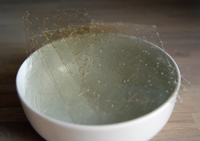
Photo from wikipedia
Fabrication of anisotropic osteochondral-mimetic scaffold with mineralized subchondral zone and gradient interface remains challenging. We have developed an injectable semi-interpenetrating network hydrogel construct with chondroitin sulfate nanoparticles (ChS-NPs) and nanohydroxyapatite… Click to show full abstract
Fabrication of anisotropic osteochondral-mimetic scaffold with mineralized subchondral zone and gradient interface remains challenging. We have developed an injectable semi-interpenetrating network hydrogel construct with chondroitin sulfate nanoparticles (ChS-NPs) and nanohydroxyapatite (nHA) (∼30-90 nm) in chondral and subchondral hydrogel zones respectively. Mineralized subchondral hydrogel exhibited significantly higher osteoblast proliferation and alkaline phosphatase activity (p < 0.05). Osteochondral hydrogel exhibited interconnected porous structure and spatial variation with gradient interface of nHA and ChS-NPs. Microcomputed tomography (μCT) demonstrated nHA gradation while rheology showed predominant elastic modulus (∼930 Pa) at the interface. Co-culture of osteoblasts and chondrocytes in gradient hydrogels showed layer-specific retention of cells and cell-cell interaction at the interface. In vivo osteochondral regeneration by biphasic (nHA or ChS) and gradient (nHA + ChS) hydrogels was compared with control using rabbit osteochondral defect after 3 and 8 weeks. Complete closure of defect was observed in gradient (8 weeks) while defect remained in other groups. Histology demonstrated collagen and glycosaminoglycan deposition in neo-matrix and presence of hyaline cartilage-characteristic matrix, chondrocytes and osteoblasts. μCT showed mineralized neo-tissue formation, which was confined within the defect with higher bone mineral density in gradient (chondral: 0.42 ± 0.07 g/cc, osteal: 0.64 ± 0.08 g/cc) group. Further, biomechanical push-out studies showed significantly higher load for gradient group (378 ± 56 N) compared to others. Thus, the developed nano-engineered gradient hydrogel enhanced hyaline cartilage regeneration with subchondral bone formation and lateral host-tissue integration.
Journal Title: Biomaterials
Year Published: 2018
Link to full text (if available)
Share on Social Media: Sign Up to like & get
recommendations!